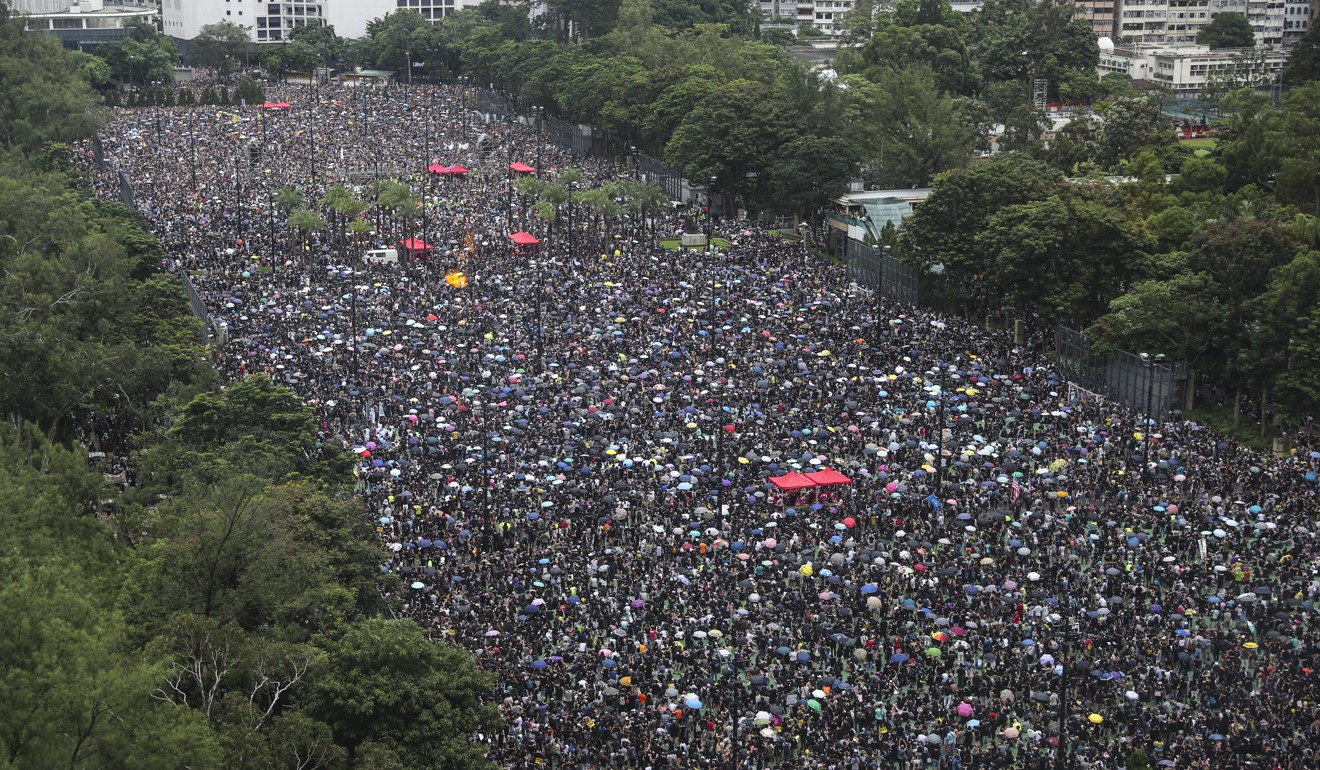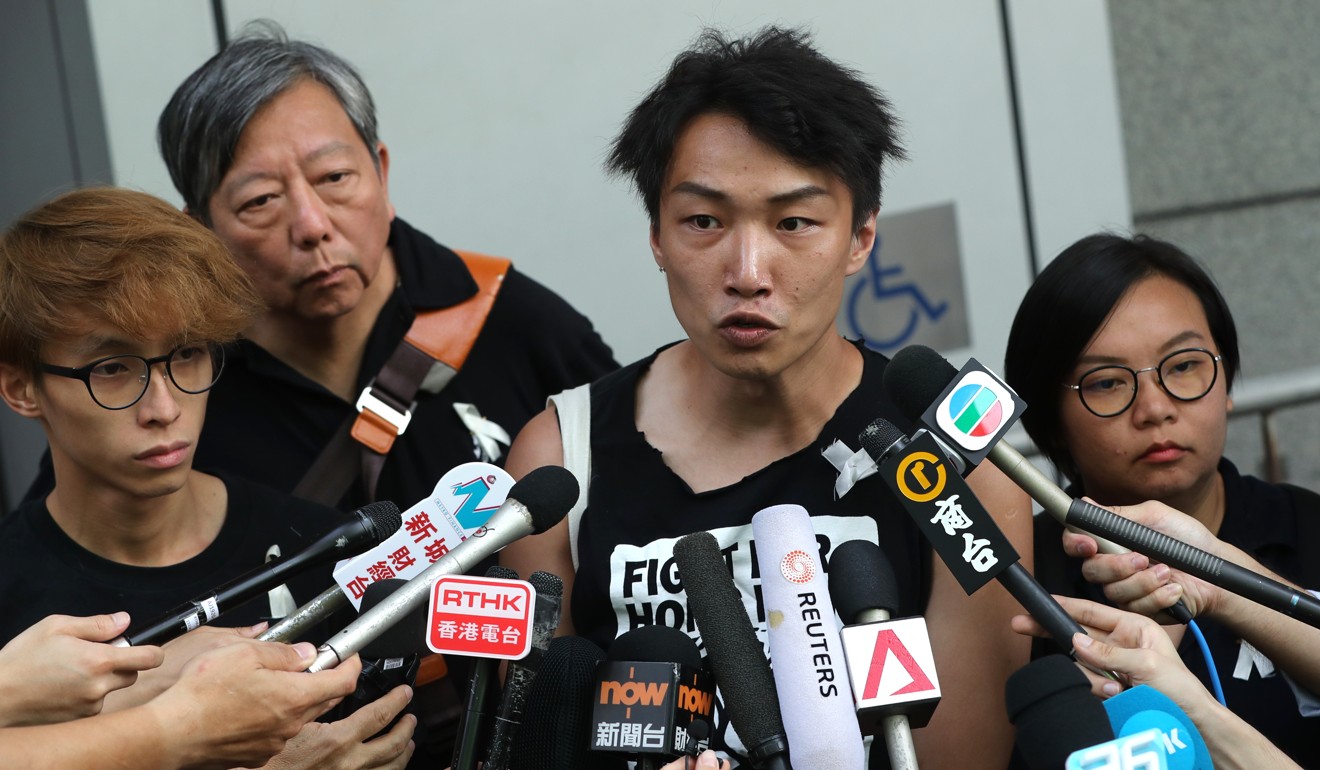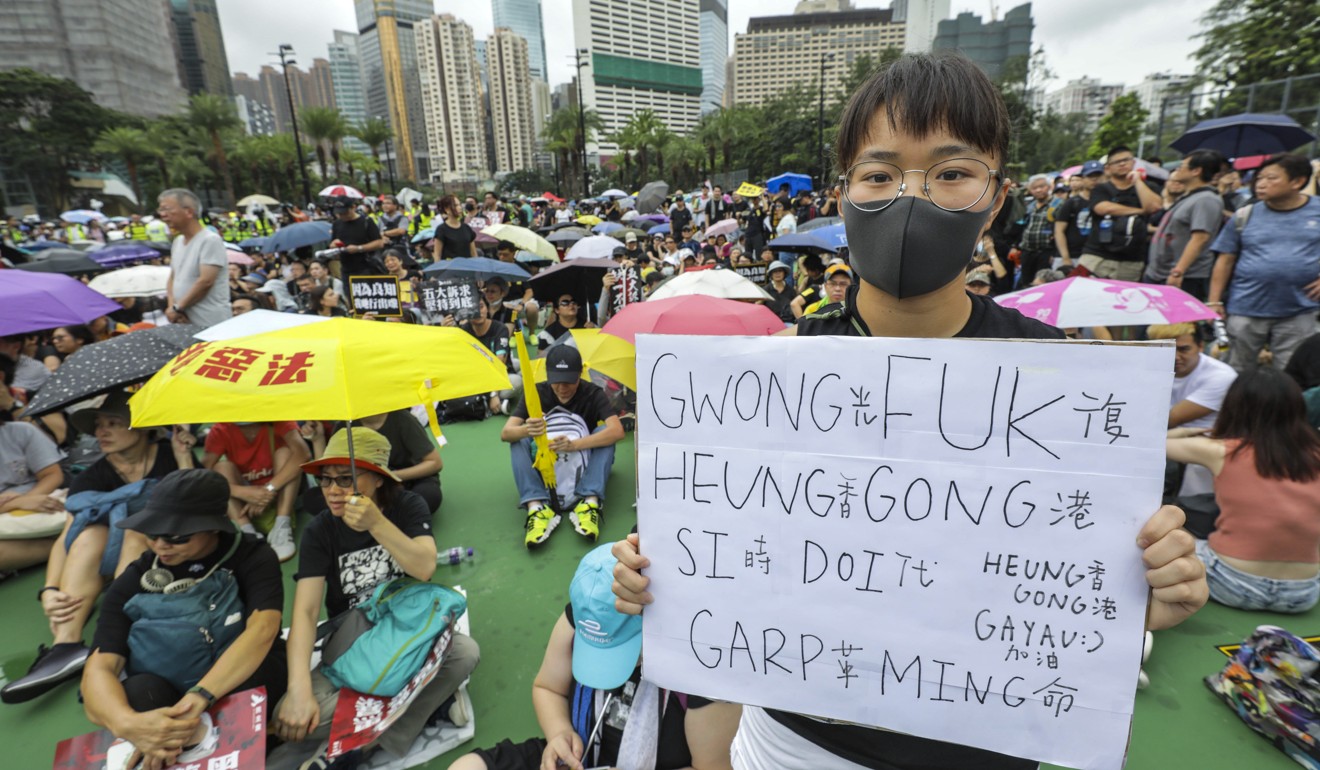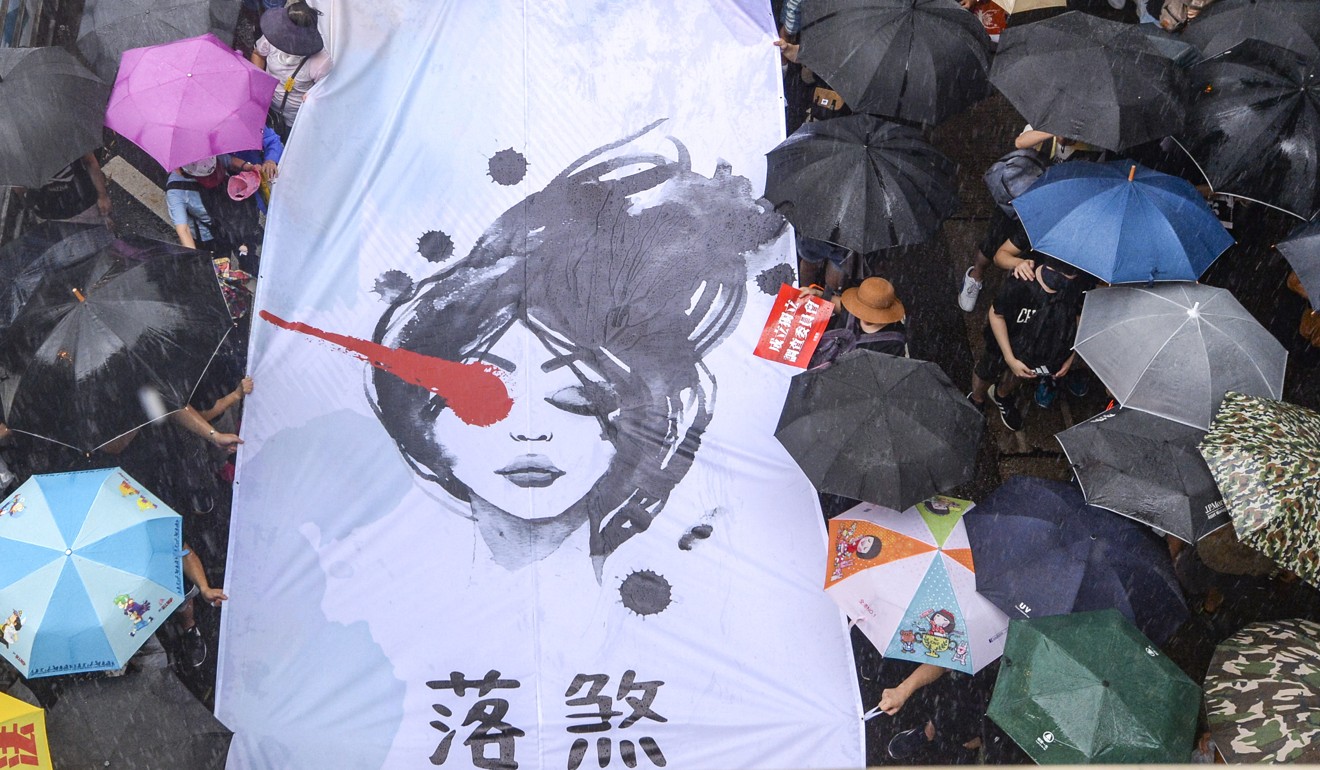
Three nights of tear gas-free protests as Hong Kong’s anti-government movement gives peace a chance
- Organiser estimates 1.7 million at Sunday’s Victoria Park rally, though police estimate is much smaller
- Government and police do not condemn the protest, although they note the disruption caused by hundreds of thousands taking over Hong Kong Island streets

Hundreds of thousands of anti-government protesters braved torrential rains on Sunday as they marched along the main thoroughfares of Hong Kong Island, determined to show the movement could regain its peaceful moorings despite the recent escalation of violence.
By night’s end, the city had wrapped up its eleventh consecutive weekend of protests, without any tear gas being fired. Groups of protesters, however, dipped into their standard toolkit to hurl insults and hard objects at police and shine laser beams at the force’s headquarters in Wan Chai.
Nonetheless, Hong Kong recorded three straight days of demonstrations that ended with no physical clashes between protesters and police, in a break from the troubling pattern of the past few weeks, which had prompted condemnation from the central and local governments.
Organisers from the Civil Human Rights Front estimated 1.7 million people were at the core of the march, as volunteers counted the numbers just in the areas closest to the starting rally in Victoria Park, between Causeway Bay and Fortress Hill.

“There were large numbers of people from Causeway Bay to Central that we were unable to take into account, so I believe the actual turnout is much larger than 1.7 million,” the Front’s convenor, Jimmy Sham Tsz-kit, said. Police put the estimate at 128,000 as the rally peaked.
By 1.30pm, even though the gathering was supposed to start at 3pm, it became clear that another sea of black was about to flood the streets as wave upon wave of protesters tried to converge on the park, only to be pushed very quickly onto neighbouring roads.
“Today has been peaceful, which is exactly what [Hong Kong leader] Carrie Lam Cheng Yuet-ngor asked for … Lam must respond to the five demands in order to show Hongkongers’ peaceful and rational expression can be heard, accepted and met,” Sham said.
He was referring to the list of calls from protesters, including those for a complete withdrawal of the now-abandoned extradition bill and an independent probe into the police’s use of force.
“If she continues to turn a deaf ear, she will be instigating more radical struggles,” Sham said.
Bonnie Leung Wing-man, vice-convenor of the Front, said police created chaos by not allowing the march in the first place, allowing only the rally. Protesters were calling for first aid every few minutes and officers were nowhere to be seen, she said.
In a change of tone, a government spokesman this time did not use the word “condemn” and described the rally as “generally peaceful”, even though the demonstrators, he noted, had occupied main roads, causing traffic jams and disruption.
“The most important thing currently is to restore social order as soon as possible. The government will begin sincere dialogue with the public, mend social rifts and rebuild social harmony when everything has calmed down,” the spokesman said.
The Front had to confine Sunday’s event to a rally in Victoria Park as police banned a march, citing safety concerns.
But in the end the sheer numbers meant organisers had to start a procession to allow people to move. They said police accepted their decision and they did not think they were breaking the law.
Still, the Front said it planned to lodge a judicial review against the so-called ban on the march and had already submitted an application for a march on August 31 from Chater Garden to Beijing’s liaison office in the city.

On Sunday afternoon, the biggest rally since the July 1 march started taking shape. Six soccer pitches and the central lawn in Victoria Park were blanketed in black by 3pm, prompting organisers to start marching in the direction of Wan Chai, even as more people tried to pour into the park.
Just about then, the heavens opened and the umbrellas went up. This time, the canopy of colourful umbrellas provided shelter from inclement weather rather than a cover for hiding protesters’ identities or fighting police.
As the brolly brigade made its way onto the wet streets, the defiant protesters – by now fully drenched – kept chanting: “Go Hongkongers!”
Among those in the crowd was Kiki Chan, 32, who said it had taken her almost two hours by MTR and walking to get from Sheung Wan to Victoria Park because of the traffic disruption.
Chan slammed the police’s arrangement, saying she had seen people forced to walk on roads as cars sped by.

“The police should have expected the massive crowd,” she said. “It appears to me they just want to stop it from happening, solely because of their stance.”
Hennessy Road was occupied heading both east and west, as were stretches of Harcourt Road in Admiralty and on to Central.
The procession’s leaders included such pro-democracy veterans as Albert Ho Chun-yan, Lee Cheuk-yan and “Long Hair” Leung Kwok-hung. They ended the gathering at the Court of Final Appeal, where they called on marchers to disperse peacefully.
In recent weeks, protesters and police both had escalated their use of force as the campaign against the extradition bill morphed into a full-blown anti-government movement.
Petrol bombs, bricks and other projectiles were hurled at a dozen police stations across the city as officers in return fired more tear gas, rubber bullets and beanbag rounds, one of which was believed to have hit a protester in the eye. An image of the woman who suffered the injury was used in a poster during Sunday’s march.

Last Tuesday, protesters sparked widespread criticism at the airport after assaulting and trussing up with cable two mainland Chinese men mistaken for undercover agents.
A 25-year-old IT technician, who only gave his surname, Wong, said he had originally been a frontline protester. “But I have given up resorting to violent means, after all the escalations have failed to bring changes,” he said.
Police remained unseen for most of the march, but several groups of riot police were assembled at Connaught Road West, a block east of the liaison office, Beijing’s main representative in the city and a previous target of protesters’ attacks.
A police source revealed to the Post that two of the force’s three anti-riot vehicles, equipped with water cannons, left the Police Tactical Unit’s headquarters in Fanling and were on standby at a secret site on Hong Kong Island. In the end, they were not needed and remained out of sight.
At about 7.15pm, the force issued a statement urging motorists to avoid travelling to areas along major carriageways between Tin Hau and Western district, because the roads were occupied by “participants” of “a public meeting”.

The force was silent on whether the protesters were occupying roads illegally. The word “condemn” was also absent from the press release, another departure from previous statements.
But near police headquarters, water barricades had been put up to protect the premises from new attacks by protesters who had previously pelted the building with eggs and scrawled graffiti on walls.
Later in the night, protesters began aiming laser beams at the headquarters, prompting police to issue warnings. A minor scuffle broke out among protesters at Harcourt Road but it was found to be the result of a misunderstanding.
Protesters were also seen online taking down the Chinese flag from the Guangdong Investment Tower in Sheung Wan. When the Post arrived, the flag was indeed gone, but the Hong Kong flag remained hoisted.
More than 700 protesters have been arrested so far, including 149 last weekend alone.
Additional reporting by Chris Lau, Peace Chiu, Danny Mok and Karen Yeung